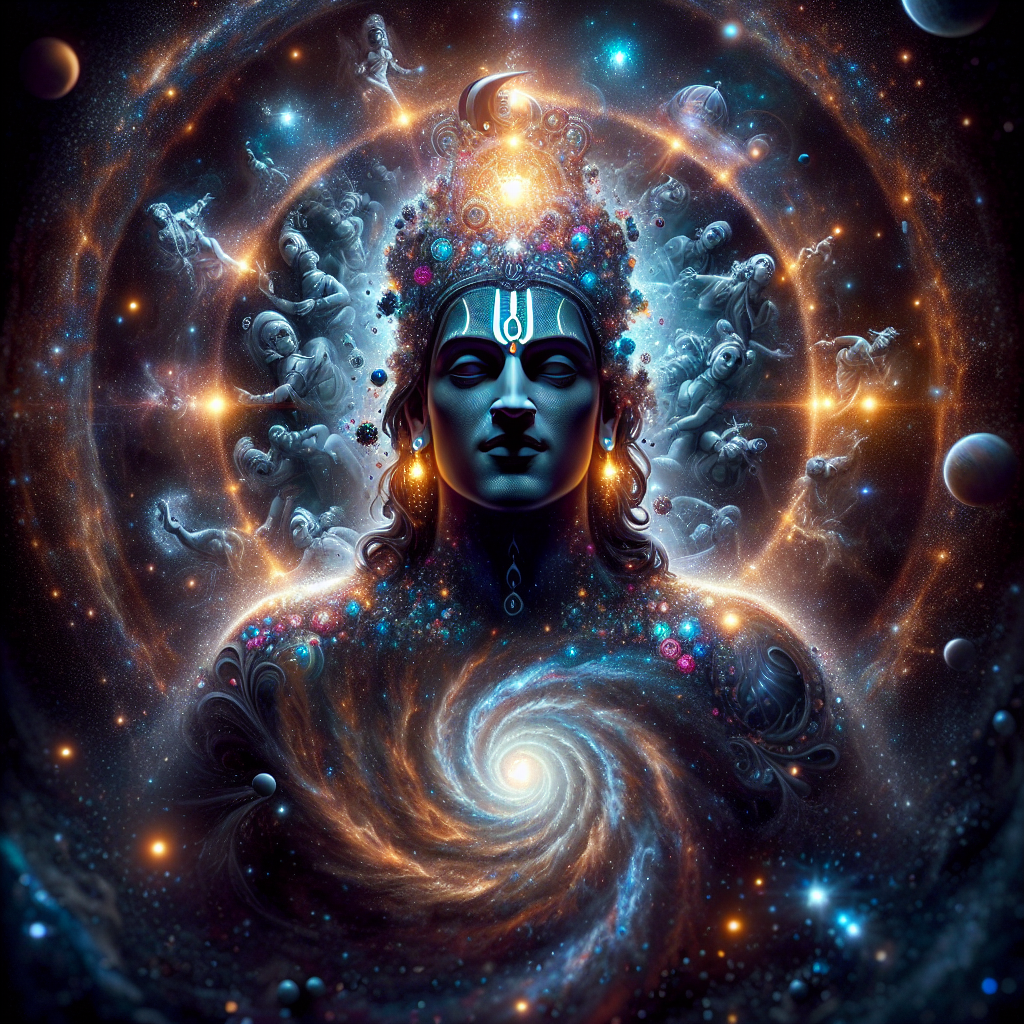
Have you ever heard of a message that’s so powerful it’s traveled across oceans and thousands of years, inspiring some of the greatest thinkers in history, even if they didn’t know its origin? Well, that’s the story of the timeless teachings of Krishna, as captured in the ancient Indian text, the Bhagavad Gita.
About five thousand years ago, on an epic battlefield, Krishna shared some really deep insights about life, duty, and the nature of reality. For centuries, this wisdom was the foundation of Indian philosophy, finding it's wa into the judiciary and civic service governance. But then, something incredible happened. These ideas started to make their way into Western thought, shaping everything from Greek philosophy to the counter-culture movements of 19th-century West (like the 1960s counterculture in America and Canada whose members variously advocated peace, love, social justice, and revolution. These ideas started to spread to the West (especially to Europe and America) and influenced many great thinkers and movements, even if they didn’t know where the ideas came from. It’s like a secret song that kept playing in the background of history!

Did Greek Philosophers Hear the Gita’s Message?
Now, there’s no concrete proof that philosophers like Plato were reading the Bhagavad Gita, but the similarities between their ideas are just too striking to ignore. Long before the first copies of the Gita reached Europe, trade routes connected India and Greece, allowing for the exchange of not just goods, but also ideas. A long time before the Gita made its way to Europe, people were trading not just goods, but also ideas. Imagine sharing your favorite video game tips with a friend from another country! Plato had this cool idea called the "theory of forms." He thought that what we see around us is just a shadow of a better, more perfect world. This is kind of like what the Gita teaches us: to look beyond the things we can touch and see, and to understand deeper truths about life. This has a really interesting parallel in the Gita’s teaching that we should look beyond the temporary material world to understand the eternal, unchanging truth of our existence.
Have you ever felt like you have different parts to your personality? Plato described the soul as having three parts: reason, spirit, and appetite. The Gita, too, describes three fundamental qualities or “modes” that influence us: goodness, passion, and ignorance. For both, the goal of a good life was to let the highest part—reason or goodness—be the guide. Were these ideas independently discovered? Or were they whispers of the same ancient truth traveling on the wind?
One of the most powerful and practical ideas in the Gita is the concept of the Sthitaprajna — a person of “steadyfast wisdom.” Kind of like the philosophy of stoicism that originated in the West. A stoic is someone who remains unshakably calm, whether they are met with wild success or crushing failure. They aren’t swayed by pleasure or pain because they have mastered their own mind. As Krishna explains it: “The one whose mind is not shaken by adversity, who does not hanker after happiness, who is free from attachment, fear, and anger, is called a sage of steady wisdom.” According to the Stoics, the ancient Greek and Roman philosophers who have become popular again today for their focus on resilience and mental toughness. The Stoic ideal was the sage who lived a life of inner tranquility by not being controlled by their emotional reactions to the outside world. They preached being “indifferent” to what you can’t control. Sound familiar? The ideal of the steady-minded Sthitaprajna and the cool-headed Stoic sage are almost identical. It’s a timeless lesson on finding peace not by changing the world around you, but by mastering the world within you.
What is Your Dharma? More Than Just “Doing the Right Thing”
Have you ever heard of Dharma? It’s a concept that’s often misunderstood as just a basis for law and order. But it’s actually much more than that. Dharma is a rich and personal idea that means “righteousness,” “duty,” and “cosmic order.” But it’s also about finding your unique purpose in the world. It’s the path that’s true to your nature and also contributes to the good of the whole.
So, while Dharma isn’t the direct blueprint for a modern courthouse, its spirit can be found in our highest ideals of justice and ethics. The core idea—that our actions should align with a sense of duty and contribute to the well-being of society—is a universal principle that resonates in both Eastern and Western quests for a just world.

Let’s discuss the Bhagavad Gita. While its influence in the ancient world was subtle, its impact on the modern West was dramatic. When the first English translation was published in 1785, it sparked excitement among some of the most innovative thinkers in Europe and America.
One group particularly inspired by the Gita was the American Transcendentalists. American Transcendentalists were a group of thinkers, writers, and reformers in the mid-19th century who believed in the inherent goodness of people and nature, and emphasized intuition, self-reliance, and individualism. Key figures included Ralph Waldo Emerson, Henry David Thoreau, and Margaret Fuller. They were part of a broader Romantic movement and critiqued the conformity of contemporary society. They valued personal spirituality over societal norms. Ralph Waldo Emerson, the leader of this movement, read the Gita and it profoundly changed his perspective. His famous concept of the “Over-Soul”—the idea that each individual soul is part of a larger, universal consciousness—was heavily influenced by the Gita. He even wrote in his journal, “I owed a magnificent day to the Bhagavad-Gita. It was the first of books.”
Emerson’s friend, Henry David Thoreau, was so inspired by the Gita that he took a copy with him to his cabin at Walden Pond, using it as a guide for living simply and independently. The Gita’s teaching about acting without attachment to the results, known as Nishkama Karma, became a key part of Thoreau’s philosophy.
Meanwhile, in Germany, philosophers like Wilhelm von Humboldt praised the Gita as “the most beautiful… philosophical song” ever written. Thinkers such as Arthur Schopenhauer, who often had a gloomy view of life, found unexpected comfort in its teachings. Schopenhauer believed that much of our suffering comes from an endless desire to live and achieve. He viewed the Gita’s advice to rise above desire as a path to true peace—a way to calm that restless urge for more.
A Message for Today: The Timeless Wisdom of Krishna
From the ancient Greeks to the American naturalists, the philosophy of Krishna has been a powerful source of inspiration for countless people throughout history. It teaches us that the human quest for meaning, purpose, and inner peace is something we all share, no matter where we come from.
Think about it: just as the ancient Greeks pondered the nature of existence, today’s thinkers and activists are grappling with similar questions. For instance, young climate activists like Greta Thunberg are not just fighting for the planet; they are searching for a deeper purpose in their lives and a way to connect with others who care about the future. Their movement echoes the timeless teachings of Krishna, reminding us that our actions can have a profound impact on the world around us.
The journey of these ideas shows us that wisdom knows no borders. It can be shared, rediscovered, and reinterpreted, becoming a part of our collective human heritage. Just as the teachings of Krishna traveled from India to influence Western philosophers, today’s global conversations about mental health, sustainability, and social justice are interconnected. People from different cultures and backgrounds are coming together to find solutions to the challenges we face, drawing on ancient wisdom as well as modern insights.
The song Krishna sang thousands of years ago is still echoing today. It reminds us that the answers to life’s biggest questions can often be found by looking within ourselves. In a world filled with distractions—like social media, fast-paced news cycles, and the pressures of daily life—taking a moment to reflect can be incredibly powerful. Mindfulness practices, such as meditation and yoga, which have roots in ancient traditions, are becoming increasingly popular as people seek inner peace and clarity.
As we navigate our own journeys, let’s remember that the wisdom of the past can guide us in the present. Whether we’re seeking to understand our place in the universe or striving to make a difference in our communities, the teachings of Krishna remind us that we are all part of a larger story. By embracing this shared heritage, we can find inspiration in each other and work together to create a brighter future for everyone.




Comments